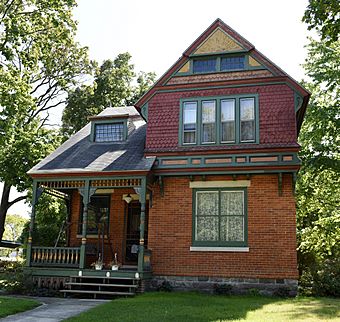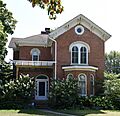Buchanan North and West Neighborhoods Historic District facts for kids
Quick facts for kids |
|
|
Buchanan North and West Neighborhoods Historic District
|
|

119 Front Street
|
|

Map of the Buchanan North & West Neighborhoods Historic District
|
|
| Location | Roughly bounded by Main, 4th, Chippewa, W. Front, S. Detroit, Chicago, Clark, Roe, and Charles Sts., Buchanan, Michigan |
|---|---|
| Architect | Lorenzo Alexander, William Wallace Cameron, et al. |
| Architectural style | Italianate, Greek Revival, Stick/Eastlake, Queen Anne, Bungalow/craftsman, etc. |
| NRHP reference No. | 11000863 |
| Added to NRHP | November 30, 2011 |
Imagine a special part of a town where many old buildings are kept safe. These buildings tell important stories about the past. That's what the Buchanan North and West Neighborhoods Historic District is! It's a historic area in Buchanan, Michigan, filled with old homes and buildings.
This district is roughly located between Main, 4th, Chippewa, West Front, South Detroit, Chicago, Clark, Roe, and Charles Streets. It was officially added to the National Register of Historic Places in 2011. This means it's recognized as an important historical place in the United States.
Contents
Exploring Buchanan's Past
How Buchanan Began
The town of Buchanan started in 1833 when Charles Cowles settled here. He built a sawmill, which is a place to cut wood. By 1841, there were a few cabins and mills in the area.
In 1842, a mill operator named John Hamilton planned out the village of Buchanan. This means he drew a map for streets and plots of land. Many mills were built, bringing workers to the area. A school was built in 1843. Churches also appeared, like the United Brethren Church in 1849.
Growth and Development
A big change happened in 1849 when the Michigan Central Railroad arrived. This made the town grow very quickly! More factories and businesses opened in Buchanan. This meant more jobs and a need for many new homes. Most of these new homes were built right here in this historic district.
The village became an official town in 1858 with 860 people. By 1860, the population had doubled! In 1878, about 2,300 people lived in Buchanan. They lived in 463 private homes.
Modern Times and Expansion
In 1905, a company that later became the Clark Equipment Company moved to Buchanan. It started with about 30 employees. By the end of World War I, over 800 people worked there. This led to a lot more homes being built in the district during the 1910s.
In 1922, the Buchanan High School was built at the edge of the district. By 1929, the company employed nearly 1,300 people. Even with a slowdown during the Great Depression, most of the empty lots in the district were filled by the 1940s.
What the District Looks Like
Buildings and Styles
The Buchanan North and West Neighborhoods Historic District is located just north and west of downtown Buchanan. It contains 698 buildings. Most of these are homes, but there are also some churches, schools, and shops.
About 428 of these are "primary" buildings like houses, churches, and schools. The rest are mostly garages and barns. The buildings are usually one or two stories tall, with two-story buildings being more common. They were built from the 1840s all the way up to the 21st century.
You can see many different architectural styles here. Some homes are in the Greek Revival style, which looks like ancient Greek temples. Others are Italianate, with decorative details. You might also spot International Style or ranch homes.
Materials and Condition
Most of the houses in the district are made of wood. However, the larger homes along Front Street often use brick and stone. The district is very well preserved. Most of the original buildings are still standing. Not many new buildings have replaced older ones.
Images for kids


